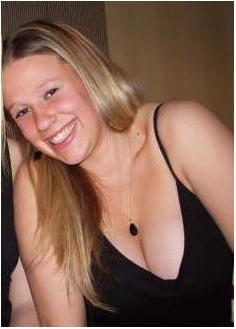

Brenna was my NSERC summer undergraduate student and a member of the CAG group this summer. It is tragic that she died in a fire on Monday August 6, 2007. The news from the Times Colonist gives a more detailed description of the tragedy. I borrowed the picture above (and then cropped it) from Brenna's facebook page- the big smile she has is how I remember her- always happy, and cheerful.
I was introduced to Brenna through Marguerite Casey, one of our COOP coordinators. She told me that Brenna was very strong academically, and especially in mathematics. She was wondering what to do with her life and was considering medical school because she was not sure what someone could do with a mathematics degree. I had started out pre-med myself, but after falling in love with computer science and math had switched to an Honours program in Computer science. Marguerite was hoping I could convince Brenna to switch to computer science as well.
I convinced Brenna to apply to work for me for the summer with the NSERC summer undergraduate program. By the time we met, it was the day before the deadline for the applications, but we managed to get it submitted on time.
Here is the formal description of our research project:
A fullerene is a molecule composed of carbon atoms which corresponds to a 3-regular planar graph with pentagonal and hexagonal faces. The goal of this project to add to a system called Fuigui which permits visualization and exploration of fullerenes. There are many open research questions regarding fullerene parameters such as the number of vertex or edge spirals, the order of a maximum independent set, and the closed shell independent set order. This workbench will facilitate making and proving conjectures about these and other fullerene parameters.
The main goals for the summer work term are:
This is joint work with Patrick Fowler (a theoretical chemist).
Or in layman's terms, her job was to help develop a java program which would aid chemists in visualizing and investigating molecules. Fullerenes have great potential for applications requiring a lightweight material with high tensile strength. There are also potential applications for drug design. here is some more information about them: http://en.wikipedia.org/wiki/Fullerene.
Brenna decided to accept the research position for the intellectual challenge even though it paid less than you would get for our typical COOP jobs. I assigned her some initial project ideas which I thought would probably take all summer, but she surprised me by completing all those task in just a couple of weeks. I enjoyed our weekly visits immensely- Brenna would show up excited to show me the progress she had made on her research, and we would often spend time talking about the next steps for future research. Some days I would be so intrigued by our discussions that I would forget that I should have gone home a long time ago.
I told her what awesome work she had done and said if she ever needed a reference letter I would be delighted to write a glowing one and she just beamed, happy that I really appreciated the work she had done. It was easy to forget that she had only finished second year and did not have many classes yet in computer science because she was so productive and successful with the tasks she was doing.
I encouraged her to apply for an NSERC postgraduate scholarship in her 4th year because she had already shown an immense potential for research. Some of the work we did together will probably be published eventually (with her name included as a co-author since her work was very valuable to the research).
Brenna made a lot of exciting changes to FUIGUI (Fullerene Interactive Graphical User Interface) which included a new picture type (drawn inside-out so that a face is on the outside avoiding the floaters). She used a spring algorithm to fix the middle of the pictures. The user can click at any level and the spring algorithm is applied from there inwards. There is also an animated version of the springs algorithm so that the iterative approach can be viewed. She also added an edit feature so that bad pictures can be fixed. Parameter comparisons are now possible for less than, less than or equal to, equal to, greater than or greater than or equal to instead of just equal to. With Sean's help, and option was added for exporting pictures as .eps files avoiding the huge files we were getting when we used a screen capture to get the pictures instead. She also improved the user interface. When I manage to recover her version of the software (I don't think she was completely done with it) I will give a CAG talk to show the great work that she did.
Brenna had a lot of fun doing research this summer and had decided to switch into computer science. I was looking forward to her taking CSC 320 (Theory of Computation) from me in the fall. I had visions of her completing a Master's degree, a Ph.D. and eventually becoming a professor involved in her own research. Brenna was vibrant, energetic, and enthusiastic and always a joy to work with. Brenna- I only knew you for a summer but I will miss you forever.
Wendy Myrvold
Full professor
Dept. of Computer Science
University of Victoria